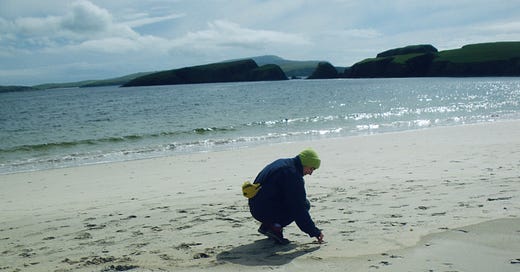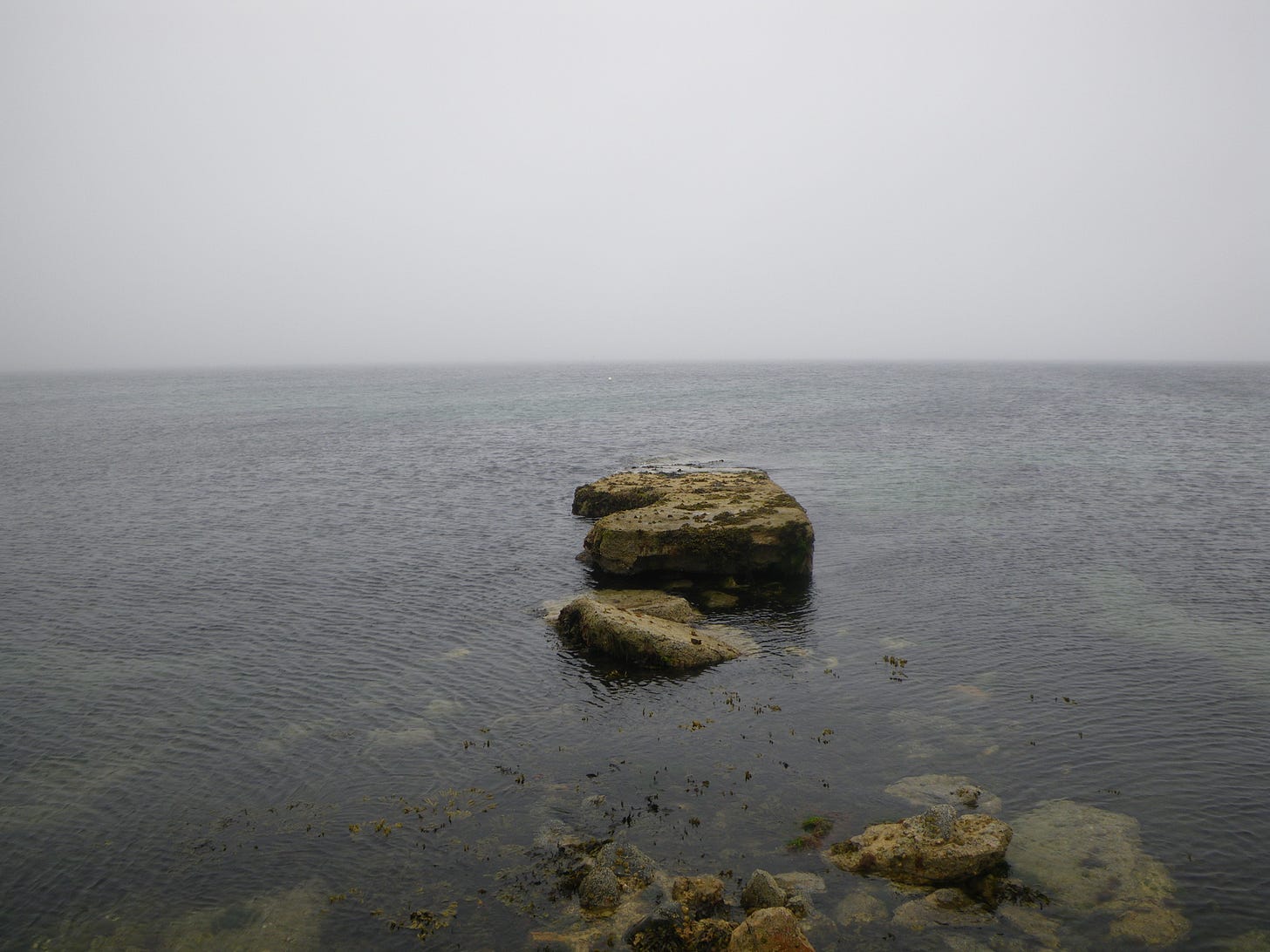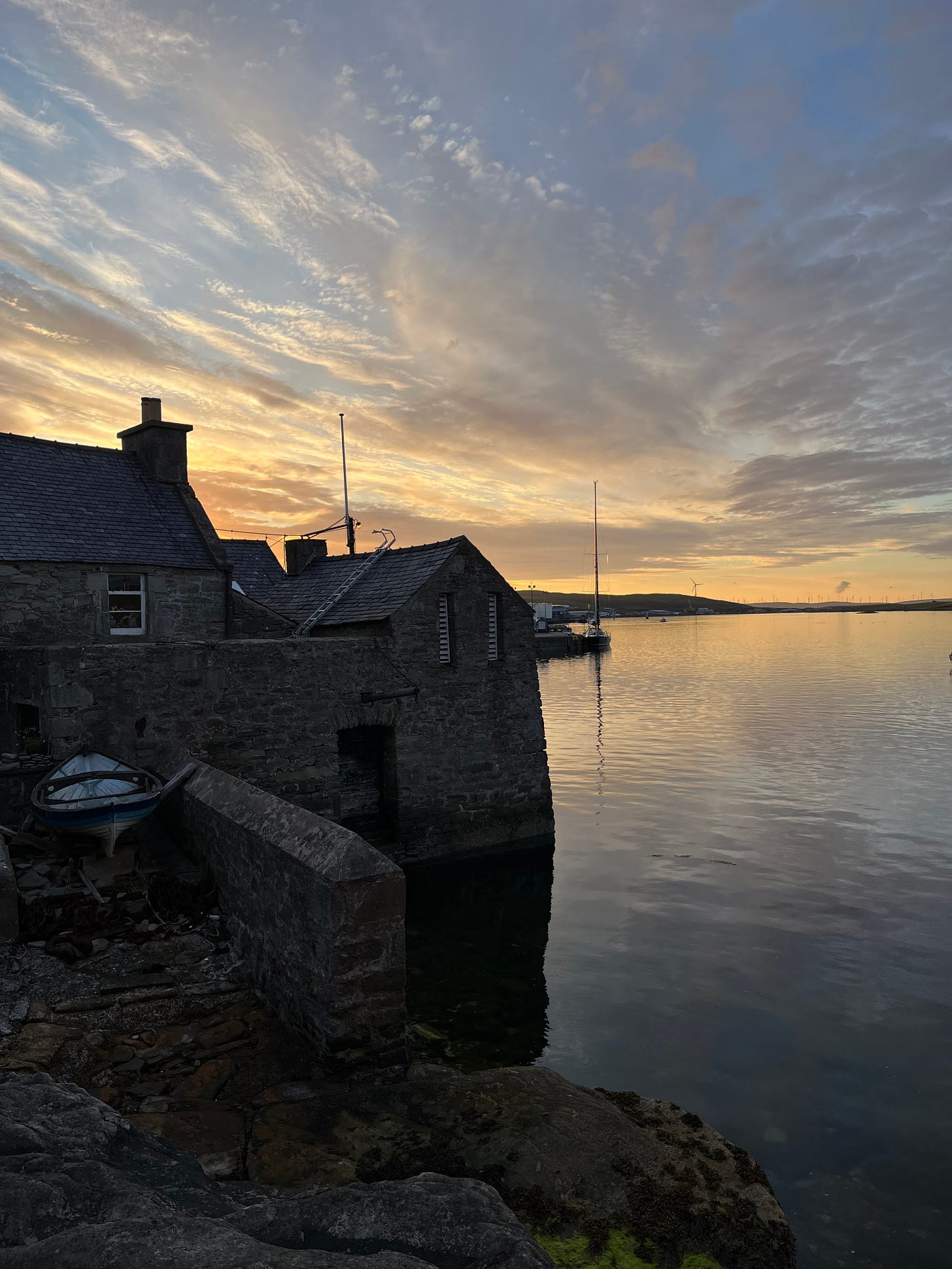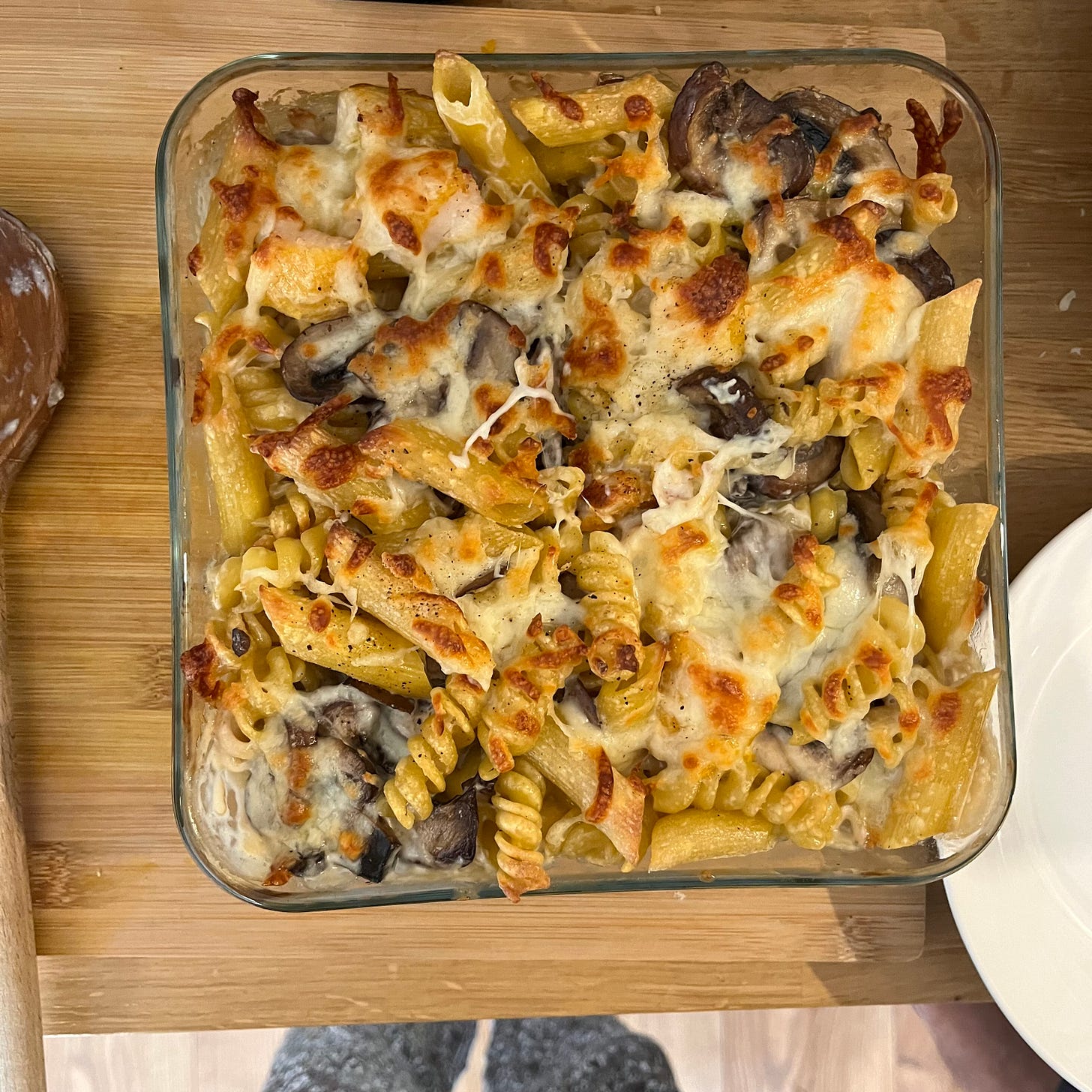#26: from Shetland
a short letter; some recommendations to taste, smell, read about and around the north isle; pasta bake for dinner
I.
It was on Fetlar, an island inhabited by 60 people and nicknamed ‘the garden of Shetland’, that I caught up with the version of myself I had been chasing since arriving on the Shetland archipelago. The journey had been chaotic. The fog banned visibility, and we had to reverse our way into the commuter’s ferry as there wouldn’t be enough space on the other side to manoeuvre. The sea was whimsical, waves rolled overboard, showering our small car, which was tucked between a high lorry and the Royal Mail delivery van. I spied on the postman scrolling on his phone. For the entire time we were in Shetland, regardless of the island and the coordinates of the hills and cliffs we hiked, the wind didn’t stop blowing once. On Fetlar, I was faced with a flat land where clouds spat at us, the thick pebbles on the coastline grinding under our feet. I picked an empty, pink sea urchin and found a well-preserved jaw skeleton underneath a pile of rocks, a few teeth still attached to the animal’s gum. My spine held me as I bended my knees, up and down, foraging and rubbing seashells against my skin. My mind drifting, desperate to swim despite the cold. Oh, let me tell you, I could cast a storm for the bounce of a breaststroke and the taste of salted water on the tip of my tongue! I too wanted to crawl inside the sea, like the baby mussels that had bearded together on a rock, only visible at low tide; like the battered cliffs; like the sheep standing solo on a patch of grass, stuck during the high tide. There aren’t any trees here, but the grassland grows tall and unapologetically, the kelp is thick and abundant along the coastline – a submarine, golden forest. That is, the wild we find in a constraint place, this thriving feeling to be alive and present because if there is one thing I’ve learnt from seeking time on islands along the years, is that their landscapes are slippery, in constant flux. So are the cells that make a body and the emotions that fuel a soul.
II.
Our time in Shetland was made most wonderful by the generosity of the locals we met, so this week I wanted to share some links to indie businesses and other creative endeavours that are inspired by Shetland:
Mella, a small handmade soap and candle company based in Unst. Perfumes are odes to the Atlantic air and wildflowers and, as I type this, I have a West Shore Spirit candle burning next to me.
Gilly B. illustrations for beautiful postcards and prints influenced by the islands and the sea. Gilly lives on a sailing boat, mostly in Shetland, and you can follow Gilly on Instagram or browse the shop on Etsy.
Food Made in Shetland by Marian Armitage: a cookbook inspired by the south-end of the island. Some recipes I can’t wait to cook: Spinach Soup with Nutmeg, Pan-Fried Catfish with Turmeric and Smoked Paprika, Bacalao, Crab Tart, Baked Hake Niçoise with Root Vegetable Mash. There are also lots of baking recipes that involve beremeal flour, so I’m on the hunt for some (any tips welcome; the cookbook recommends rye as a supplement, though I really want to try bere). You might remember I had talked about the ancestral bere when I came back from Islay a few months ago.
Moder Dy by Roseanne Watt: a beautiful poetry collection that intertwines English and Shetlandic languages. It has echoes from the heart and the seas, vivid and thoughtful; concise, it’s a good book to carry with you on a walk.
Let me start over:
Lass, you don’t have the words to hold me
on the page, and you’ll never find me there
until you understand the salt that courses
through your veins is the lifeblood
of an older conversation, one that ebbs and floods
just as the tide. These words are my gift to you.
Take them; give them a pulse.
Storm Pegs by Jen Hadfield: I picked this one at The Shetland Times Bookshop on the high street in Lerwick and have been reading it since coming back from Shetland. Penned by the celebrated poet Jen Hadfield, who moved to the Shetland archipelago in her late twenties, this is a moving memoir, retracing over seventeen years of building a life anew, and a reflection about home and time.
You can also give a listen to A Time To Keep, the title track from Lise Sinclair’s album based on the stories in George Mackay Brown's A Time to Keep. This is a collaboration between Lise and Ástvaldur Traustason, featuring musicians from the Northern Isles and Iceland: Inge Thomson, Ewen Thomson, Brian Cromarty and Icelandic translations by A∂alstein Asberg Sigur∂sson.
I’ve also loved David Attenborough’s Wild Isles documentary series. It goes beyond Shetland, including other British islands and wildlife, from the seas and oceans, to woodland, grasslands and freshwater. It’s available to stream on BBC iPlayer, if you’re based in the UK.
Finally, it’d be hypocrite not to mention Shetland, the BBC tv series based on Ann Cleeves’ books (which I haven’t read though). There is no other way to put it: I became obsessed with it a few months after I had moved to Glasgow. On long winter nights, I sat on the sofa with L., our dinners on our laps and we watched a new episode. Jimmy Perez is a no fuss, good investigator, each season has a manageable number of episodes and is centred around one case – it's unbelievably soothing when everything else in the world seems to be going so fast all the time. If you wish you could watch Columbo for the first time, with a lot less smoking involved, then this one is for you. I still haven’t watched the last season as I can’t get over Jimmy’s retirement. It’s available to stream for UK residents, on BBC One.
III.
Pasta bake is an important dish in our household. It’s one we cook to commemorate the birthdays of the people who have left us too soon, and whenever we find ourselves far from home, we hunt for an oven to make it. We’ve tried many recipes along the years – and it has often gone wrong – and, every time, Ludo claims that we’ve just eaten the ‘best pasta bake ever made’, so here you go, with a special thanks to Miranda and Callum for their hospitality and their oven. Recipe for a Smoked Basa and Chestnut Mushrooms Pasta Bake:
fresh penne and fusilli pasta (we like to mix shapes for more fun and recommend buying them fresh for the cooking process. If you don’t use fresh pasta, then you might need to boil them before and they might get soggy/add water to the bake)
oat cream
smoked basa fillet, cut in chunks
chestnut mushrooms, sliced
shaved mozzarella
Preheat the oven to 180C. In a pan, drizzle some olive oil and cook the mushrooms until tender. Add the oat cream, reduce the heat to a minimum and cover with a lid. Cook for 5 minutes (you want to keep the lid on so you can retain the water from the mushrooms and use it for the next step). Remove the lid, add the fresh pasta, increase the heat and cook for 3 minutes. The pasta should retain a bite. Turn off the heat. Add the fish and the mozzarella. Mix well. Transfer the mixture into an oven dish, add more mozzarella on top, bake until golden.
Thank you for being here. Your support is invaluable.
Margaux
PS. If you enjoy this newsletter, feel free to forward it to a friend, or two. I haven’t activated the referral/gift a subscription feature as I don’t like subscribers being sent marketing emails about these things outside of my usual newsletters. If you’d like to refer someone or know someone who would enjoy a subscription and can’t afford it, just let me know and I can comp people on your behalf. The more, the kinder around here.









